Another preprint came out at the same time as Wang et al. (2020), from the Jena Lab of the Max Planck Society: A dynamic 6,000-year genetic history of Eurasia’s Eastern Steppe, by Jeong, Warinner, et al. bioRxiv (2020).
NOTE. I have now updated the Ancient DNA Dataset, the Prehistory Atlas – with PDF and GIS files including Y-DNA and mtDNA of all newly reported samples (starting with the Neolithic) – as well as the PCA files with those from Wang et al. (2020).
The conclusions are similar, but with some interesting twists. Relevant excerpts (emphasis mine), divided into three main sections:
- Pre-Tocharian to Proto-Tocharian:
- Afanasievo pastoralists reached the eastern Steppes.
- Afanasievo…a dead end?
- Chemurchek stems from Afanasievo.
- Proto-Tocharian to Common Tocharian:
- Old Uyghurs:
I. Pre-Tocharian to Proto-Tocharian
I.1. Afanasievo pastoralists reached the eastern Steppes
Pastoralism in Mongolia is often assumed to have been introduced by the eastward expansion of Western Steppe cultures (e.g., Afanasievo) via either the Upper Yenisei and Sayan mountain region to the northwest of Mongolia or through the Altai mountains in the west (Janz et al., 2017). Although the vast majority of Afanasievo burials found to date are located in the Altai mountains and Upper Yenisei regions outside of Mongolia (Honeychurch, 2017), an Early Bronze Age (EBA) site in the southern Khangai Mountains of central Mongolia has yielded Afanasievo-style graves with proteomic evidence of ruminant milk consumption (Wilkin et al., 2019). Analyzing two of these individuals (Afanasievo_Mongolia, 3112-2917 cal. BCE), we find that their genetic profiles are indistinguishable from that of published Afanasievo individuals from the Yenisei region (Allentoft et al., 2015; Narasimhan et al., 2019), and thus these two Afanasievo individuals confirm that the EBA expansion of Western Steppe herders (WSH) did not stop at the mountain ranges separating the Western and Eastern Steppes (Allentoft et al., 2015), but rather extended a further 1500 km eastwards into the heart of central Mongolia.
Both samples are the same published in Wang et al. (2020), and the different Y-DNA calls for one of them and mtDNA for the other means that both labs have independently confirmed the R1b-P310 call for I6222, representing the oldest R1b-L51 sample reported to date. Together with the also probably archaic Khvalynsk-related J1a lineage, and their fully (Pre-)Yamnaya-like ancestry, both can be used to trace this eastern population directly back to the Indo-Tocharian homeland in Late Repin, and indirectly to the R1b-rich Indo-Anatolian homeland in Khvalynsk.
Even more interesting is the potential ancestral connection that this lineage shows with Bell Beakers, who spread North-West Indo-European all over Europe, suggesting that we might be able to see an early division of Repin clans coinciding with the known Northern and Graeco-Aryan dialects of Late Proto-Indo-European. The distribution of R1b-L51 on both ends of the Yamnaya-related expansions fits (the mainstream idea of) an early Northern split, compared to a late Graeco-Aryan community remaining in loose contact to allow for their common innovations.
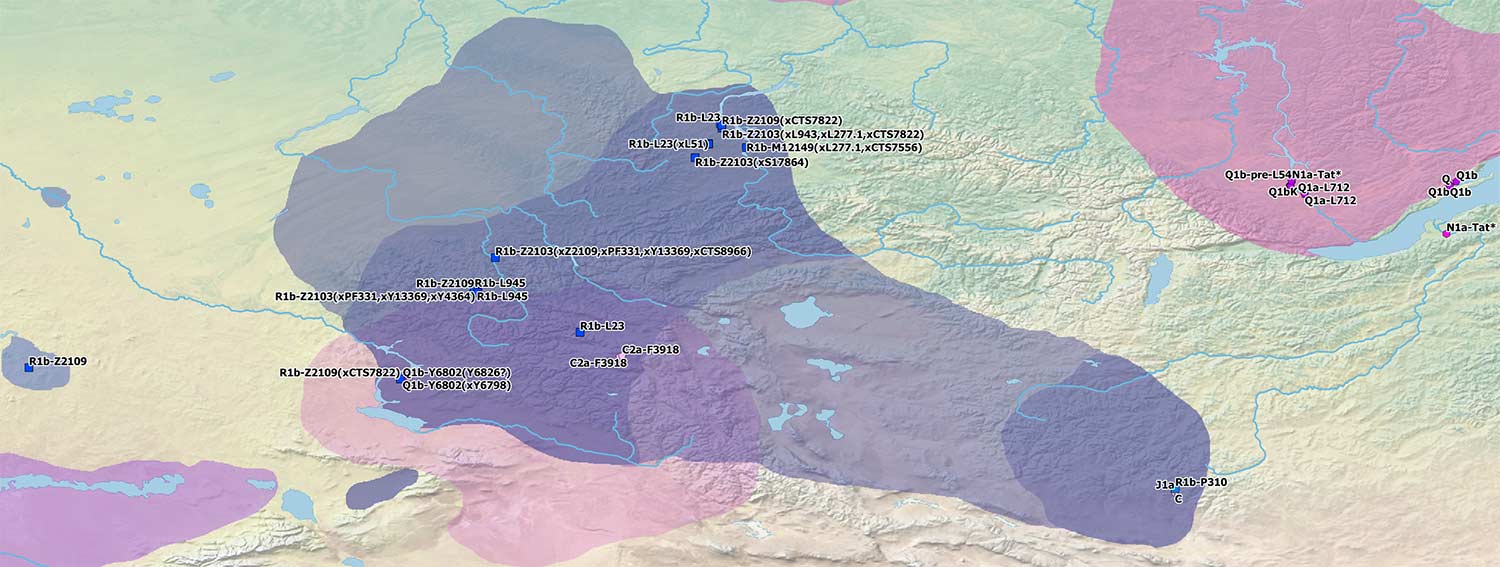
Regarding the emergence of pastoralism, from Wilkin et al. (2020):
Our results demonstrate the oldest known evidence of dairy consumption in Mongolia and the eastern Eurasian steppe (circa 3000–2500 bc), in the form of Early Bronze Age Afanasievo- and Chemurchek-associated individuals in both central and western Mongolia (Table 1). Previous ancient DNA analysis of one of the individuals at Shatar Chuluu showing ruminant dairy proteins (AT-26) was shown to have a non-local mitochondrial haplogroup consistent with western steppe herder populations, supporting the interpretation of individuals associated with the Afanasievo culture as migrants from eastern Europe via the Russian Altai and a probable vector for the initial introduction of domestic animals into Mongolia. The identification of ruminant milk proteins (Ovis and Bovinae/Ovis) supports the domestic nature of fauna found in these burial features and indicate that dairy pastoralism formed an important element of the subsistence base of these late fourth millennium bc transcontinental migrants. Most significantly, they suggest that human migrations associated with the expansion of the Afanasievo culture present a viable candidate for the initial introduction of dairy and domestic livestock into eastern Eurasia. In this study, the earliest individual in this dataset showed evidence of dairy consumption.
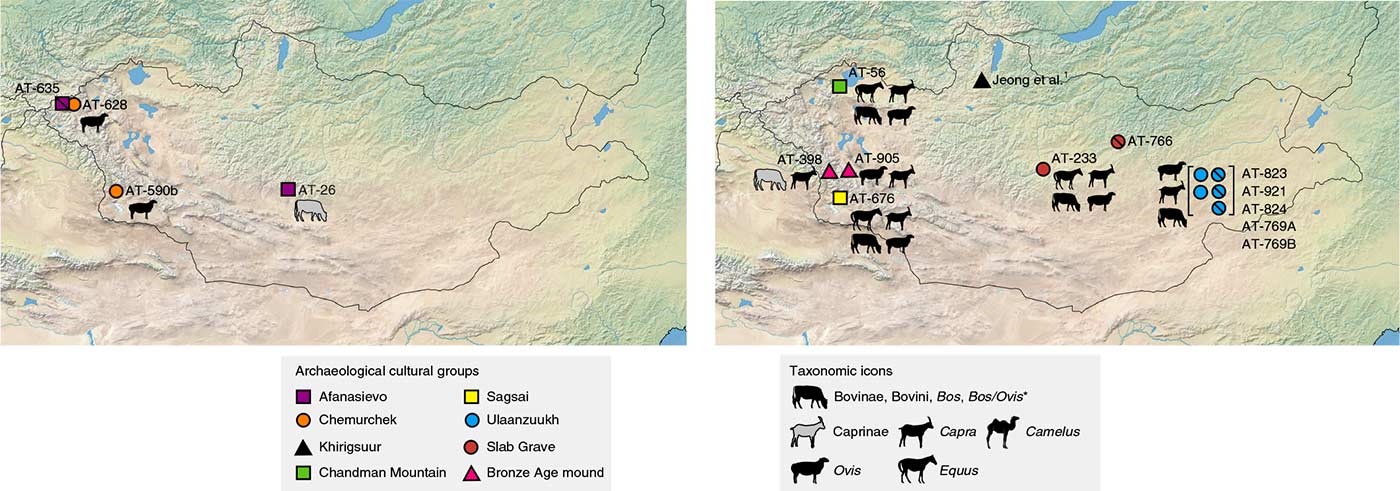
I.2. Afanasievo…a dead end?
Although the Afanasievo-related expansion may have introduced dairy pastoralism into Mongolia (Janz et al., 2017), the people themselves do not seem to have left a long-lasting genetic footprint. An Afanasievo-style burial (Afanasievo_KUR001) excavated in the Mongolian Altai and dating to approximately 500 years later (2618-2487 cal. BCE), was found to have a distinct and mostly ANA (~90%) derived ancestry, with only a minor component tracing back to the Afanasievo (~10%).
We analyzed two Chemurchek individuals from the southern Altai site of Yagshiin Huduu and one from Khundii Gobi (KUM001) in the northern Altai. Compared to Afanasievo_Mongolia, the Yagshiin Huduu individuals also show a high degree of Western ancestry but are displaced in PCA, having also a strong genetic affinity with ANE-related ancient individuals such as AfontovaGora3, West_Siberia_N, and Botai. We find that these Chemurchek individuals (Chemurchek_Altai) are genetically similar to Dali_EBA, a contemporaneous individual from eastern Kazakhstan (Narasimhan et al., 2019). The genetic profiles of both the Yagshiin Huduu and Dali_EBA individuals are well fitted by two-way admixture models with Botai (60-78%) and groups with ancient Iranian-related ancestry, such as Gonur1_BA from Gonur Tepe, a key EBA site of the Bactria-Margiana Archaeological Complex, and ancient individuals from post-BMAC Bronze Age sites in southeastern Uzbekistan. Although minor genetic contributions from the Afanasievo-related groups cannot be excluded, Iranian-related ancestry is required for all fitting models, and this admixture is estimated to have occurred 12±6 generations earlier (~336±168 years) when modeled using DATES (Narasimhan et al., 2019). Because all proxy source populations used in this modeling are quite distant in either time or space from the EBA Altai, the proximate populations contributing to the Chemurchek cannot be precisely identified, but future research in genetically unsampled regions such as Xinjiang may provide important clues.
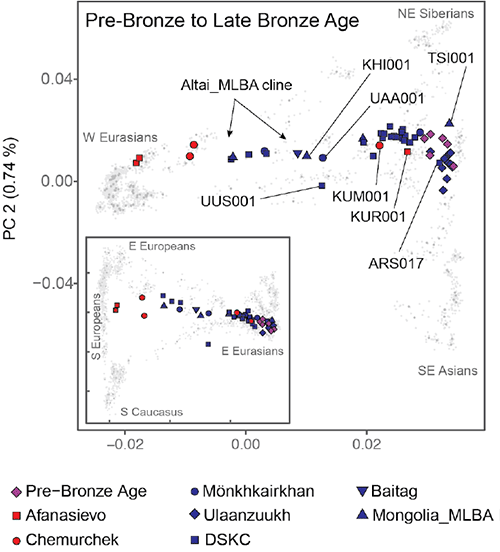
In the northern Altai, the third Chemurchek individual in our study (KUM001) has additional northeast Asian ancestry, similar to levels seen in Afanasievo_KUR001 (Fig. 3a). KUM001 can be modeled as a mixture of Chemurchek-related (~30%) and ANA ancestry (~70%). The high proportions of local ANA ancestry in KUR001 and KUM001 suggest that the arrival of Afanasievo and later Chemurchek pastoralists did not necessarily displace local Altai peoples, despite the strong cultural and economic impact of these herders. Indeed, the cultural features that they first introduced, such as mortuary mound building and dairy pastoralism, continue to the present day.
The findings as they are reported might suggest an expansion of ANE/WSHG+Iran_N-like peoples – that is, Central Steppe EMBA-like, based on Narasimhan et al. (2019) – from the (south-)west into the Altai and Xinjiang, potentially related to the spread of agriculture. However, the genetic profile of the available Chemurchek samples suggests the opposite movement of peoples, from Afanasievo to the south, and these outliers probably represented the regional population present before the intrusion of Afanasievo-related peoples.
From the recent Wilkin et al. (2019):
(…) under the warm climate of the middle Holocene, low-investment agropastoralists in Central Asia directed the dispersal northward along the western Tian Shan Mountains of wheat and naked barley cultivation. The earliest domesticated crops thus far recovered from the Altai Mountains date as early as 5,200 cal bp [in Afanasievo and Chemurchek contexts]. The economy at the site was probably diverse, with mixed hunting, fishing, foraging, herding and low-investment agriculture. The early domesticated crops provided people with higher economic flexibility, which enabled population growth and long-term adaption to a dynamic environment in the mountain area of the northern latitudes. The expansion of the steppe ecozone into Middle Asia, with a long-term global cooling trend since the middle Holocene, provided low-investment agropastoral economies more adaptability and extended their living space at the same time. The abrupt cold events during and after the mid-Holocene transition [~4,000 cal bp] drove the steppe populations southward and accelerated the exchange of crops, technology and cultural traits in Eurasia.
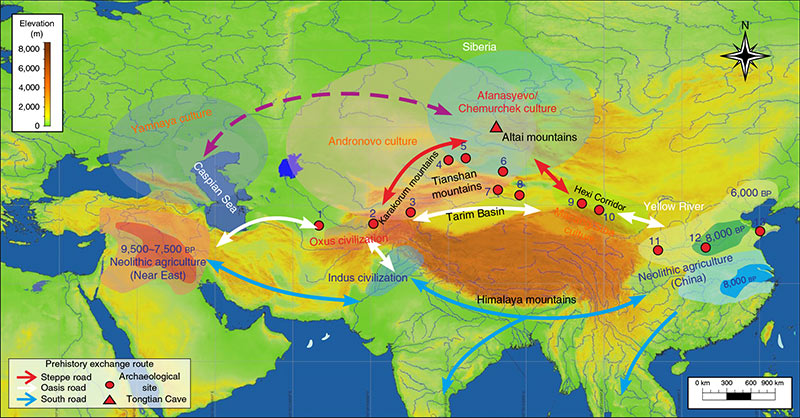
I.3. Chemurchek stems from Afanasievo
I have the impression that the author(s) of the paper tried very hard to show a migration of BMAC-related peoples (well before and well after the potential spread of the Oxus civilization), probably to prove a northeastward spread of farmers through the Inner Asia Mountain Corridor, akin to the Neolithic waves in Europe and Africa.
This must be the reason why the paper gets lost trying to find unlikely ancestral sources in Mongolia, confusing the actual temporal and cultural context of some of the samples they analyzed (such as these Afanasievo and Chemurchek individuals), which is even stranger in this case, because both labs publishing East Asian samples shared and worked on roughly the same data (and part of both teams work at Jena??).
In fact, whereas Wang et al. (2020) covers the complexity of the cultural attribution of I13957 and I6361 (KUM001) in the main discussion, Jeong et al. (2020) didn’t even take into account the precise cultural context of the latter, attributing KUM001 directly to Afanasievo, and deriving conclusions from it and from a “Chemurchek” sample KUR001 , neither of which belongs to Afanasievo or Chemurchek, but to another, entirely different Mongolia EBA Ulgii culture.
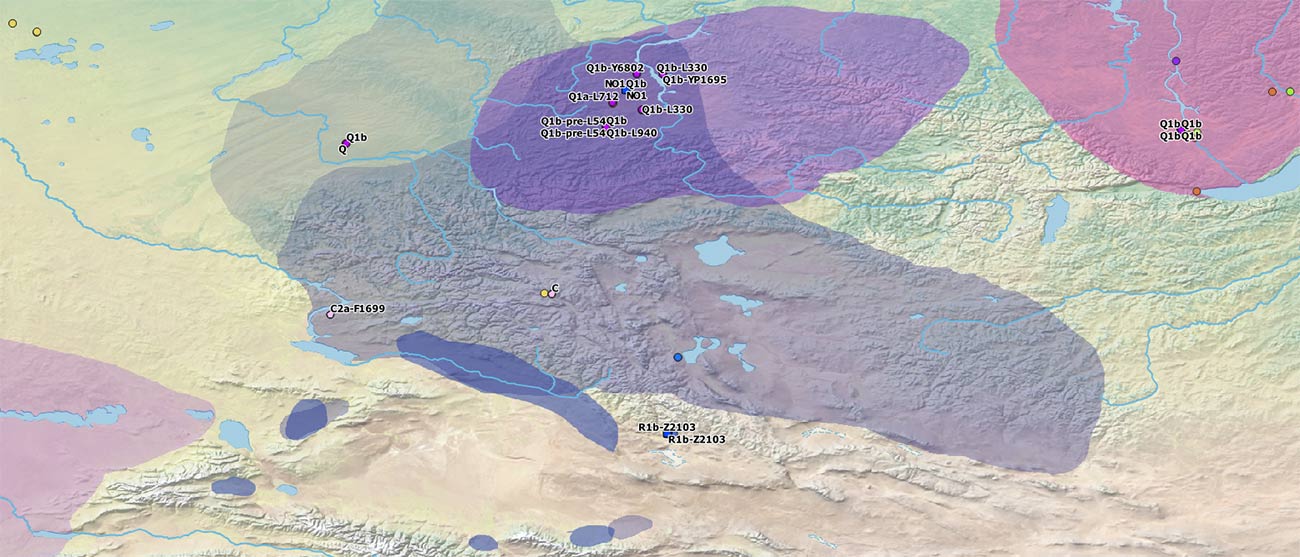
In words of (an understandably angry, left-out) Kovalev, the archaeologist in charge of excavating these individuals and many other samples from the region, seeing how Jeong et al. (2020) conflate different cultures and reach wrong conclusions about them (at the same time as he is merely acknowledged, instead of included as co-author, as in Wang et al. 2020):
Sample KUR001 (AT_635) don’t belong to Afanasievo. It was rectangular barrow in Chemurchek tradition (named Kurgak govi #2) situated nearby Afanasievo kurgan (named Kurgak govi #1). This sample would need to be combined with sample KUM001 AT_628 (Kumdi govi #1 burial 2). It are secondary burials in ritual structures of Chemurchek types. I think now it was mixed group of people with Chemurchek and East Kazakhstan cultural traditions.
NOTE. I have used the rest of his comments on the paper to reclassify the samples in the Ancient DNA Dataset. I must say I am relieved to see that I am not the only one lost among so many different cultural groups close to the Altai, and that even archaeologists specialized in Mongolian prehistory working with second-hand information, like the group from Jeong et al (2020), can’t get things right.
A lack of significant Afanasievo-related ancestry among some sampled Chemurchek groups is indeed possible, based on the presence of an early Ulgii_EBA-like male (I13957), of hg. C2a-F3918, with Afanasievo traditions, and on the presence of Afanasievo ancestry in both samples of the Ulgii culture, one of hg. C2a-F3918 (hence most likely acquired through female exogamy). However, all data interpreted together strongly suggests that I13957 is another misclassified Ulgii EBA individual, and that these Afanasievo- and Chemurchek-like cultural traits in the Ulgii region haven’t been properly assessed.

It is, then, much more likely that a local Ulgii EBA group imitating Afanasievo traditions emerged in the area from a population similar to the Mongolia_N_North cluster (rich in the same C2a-F3918 haplogroup in the end-6th millennium BC), at the same time as Afanasievo proper evolved and migrated forming the Chemurchek culture, based on the early (and properly classified) Chemurchek samples reported in Wang et al. (2020), who show an ancestry coming – without a doubt – from a (Pre-)Yamnaya-like source, as are their R1b-Z2103 lineages.
These are some admixture models for both available Chemurchek individuals, confirming the results from Wang et al. (2020), which suggests that the Ulgii EBA-related peoples were the ones representing a dead end in terms of their ancestry and lineages in the region:
II. Proto-Tocharian to Common Tocharian
II.1. Samoyedic and Yeniseic
The westward expansion of Baikalic Q1b lineages (a haplogroup proper of Modern Yeniseians) with Baikal_EBA ancestry first, and the more recent R1a-Z645 lineages of Corded Ware-related ancestry reaching up to the eastern steppe with the Seima-Turbino phenomenon strengthen the hypothesis of Pre-Samoyedic peoples replacing Yeniseic in the area, acquiring some of their diverging typological features from its substratum. For more on this, see Samoyedic shows Yeniseic substrate; both influenced Tocharian.
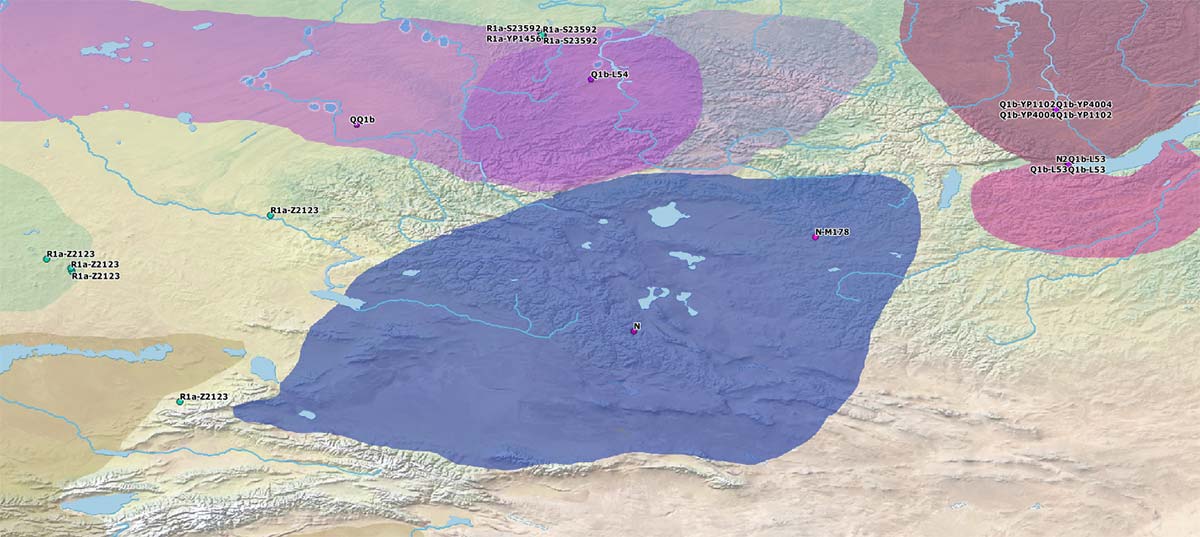
An interesting finding in that regard might be the early Xiongnu sample of hg. R1a-Z283 from Naimaa Tolgoi, Arkhangai (ca. 150 BC – AD 120?). While R1a-Z280 has already been found in Srubnaya, it is only present to the east of the Urals in Pre-Ugric-speaking Mezhovskaya (ca. 1500 BC), since Late Proto-Indo-Iranians probably expanded east- and southwards after a strong bottleneck under R1a-Z93 (before admixing heavily in Turan). On the other hand, we already know that Finno-Permic and Ugric peoples, belonging to different populations from both sides of the Urals, share R1a-Z280 and rare Z93 lineages not found among Indo-Iranians.
The presence of R1a-Z283 as far east as Mongolia further supports the proposed origin of the Andronovo-like horizon directly in Abashevo, and its nature as the vector of expansion of Ugro-Samoyedic through the Siberian forest-steppes and forests, most likely under R1a-Z645 bottlenecks different from those affecting Indo-Iranians, which will further help us differentiate groups of the Indo-Iranian-speaking Andronovo from the Uralic-speaking Andronovo-like cultural horizons.
In fact, R1a lineages reaching as far as the Altaic homeland well before the emergence of Turkic (first) and Mongolic (later) add another twist to the often-cited Uralic-Altaic similarities. For example, vowel harmony is believed to be a recent phenomenon in both Altaic languages, despite the simplistic typological arguments of the past century (particulary among the Soviets) arguing for a “Uralo-Altaic” language family, and it might also explain (as a Samoyedic-related influence) similar typological features found in Yukaghir, without a need to argue for a disputed Uralo-Yukaghir group within Indo-Uralic.
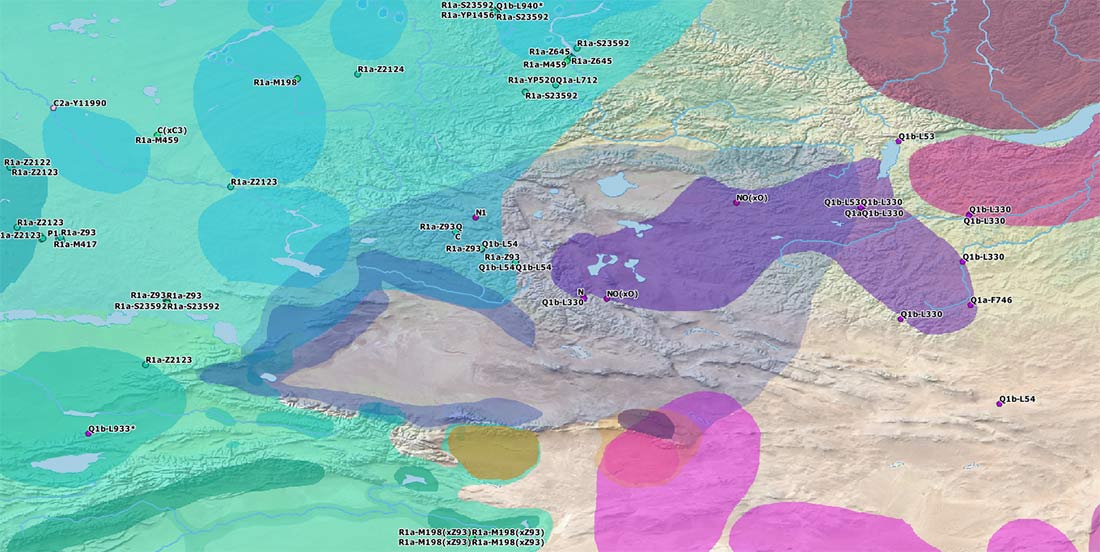
II.2. Unsampled MLBA Tocharians
The Middle and Late Bronze Age sampling offers enough data about the Mongolian (Southern) Altai, especially in the Khovd region, to discard a significant continuity of Afanasievo-related peoples, coinciding with the apparent replacement of vast Chemurchek territories by populations from the East (of Baikal_EBA-related ancestry) and West (of Corded Ware-related ancestry).
Nevertheless, sample UAA001, an early Munkh-Khairkhan male from Ulaan Goviin Uzuur, Khovd (ca. 1874-1631 BCE), of hg. NO, shows Afanasievo-related ancestry, rejecting Sintashta as a proxy, which points to the survival of Chemurchek-related peoples close to this area north of the Tian Shan at least up to the Middle Bronze Age, at the same time as Indo-Iranians were probably spreading with Sintashta-related ancestry into the Xiaohe cultural horizon.
Furthermore, the model of Tocharians assimilating a Pre-Samoyedic substrate already under Yeniseic influence suggests that the Proto-Tocharian community survived in close proximity to these Corded Ware-like peoples from the Altai, probably just before spreading south through the Tian Shan, but it could possibly also be explained as intense contacts through the Tian Shan during their westward migration within the Tarim Basin.
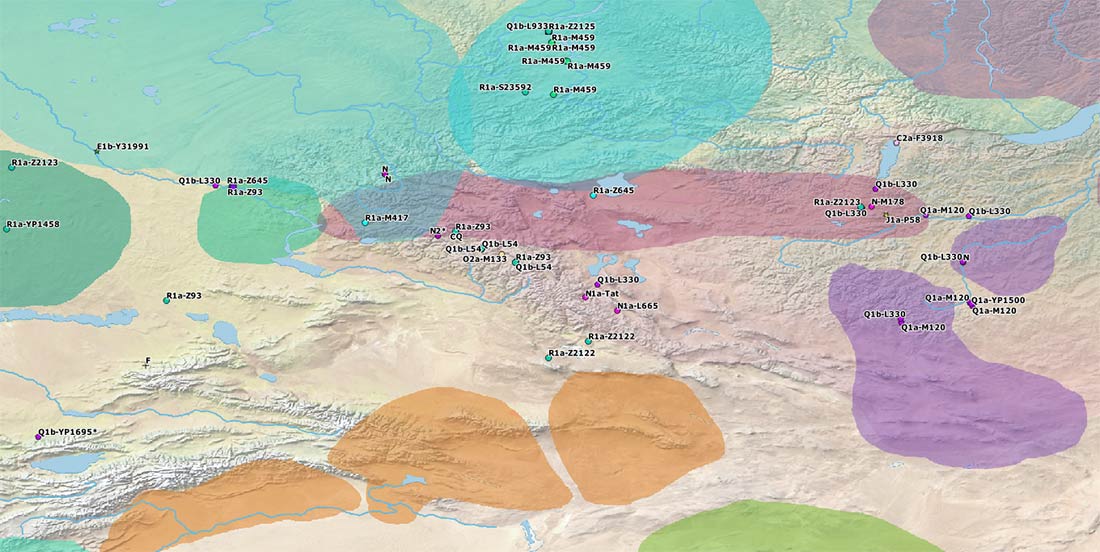
II.3. Shirenzigou IA
The admixture of Chemurchek shows that Afanasievo ancestry survived among early Proto-Tocharians, but it is to be expected that their long-range close interactions with Corded Ware-like peoples in the Altai (Uralic speakers) and in the Tarim Basin (Indo-Iranian speakers) is also reflected in the ancestry of historical Tocharians.
A PCA including modern East Asian samples shows how the Shirenzigou nomads diverge from a Corded Ware-related cline to a Chemurchek-related one:
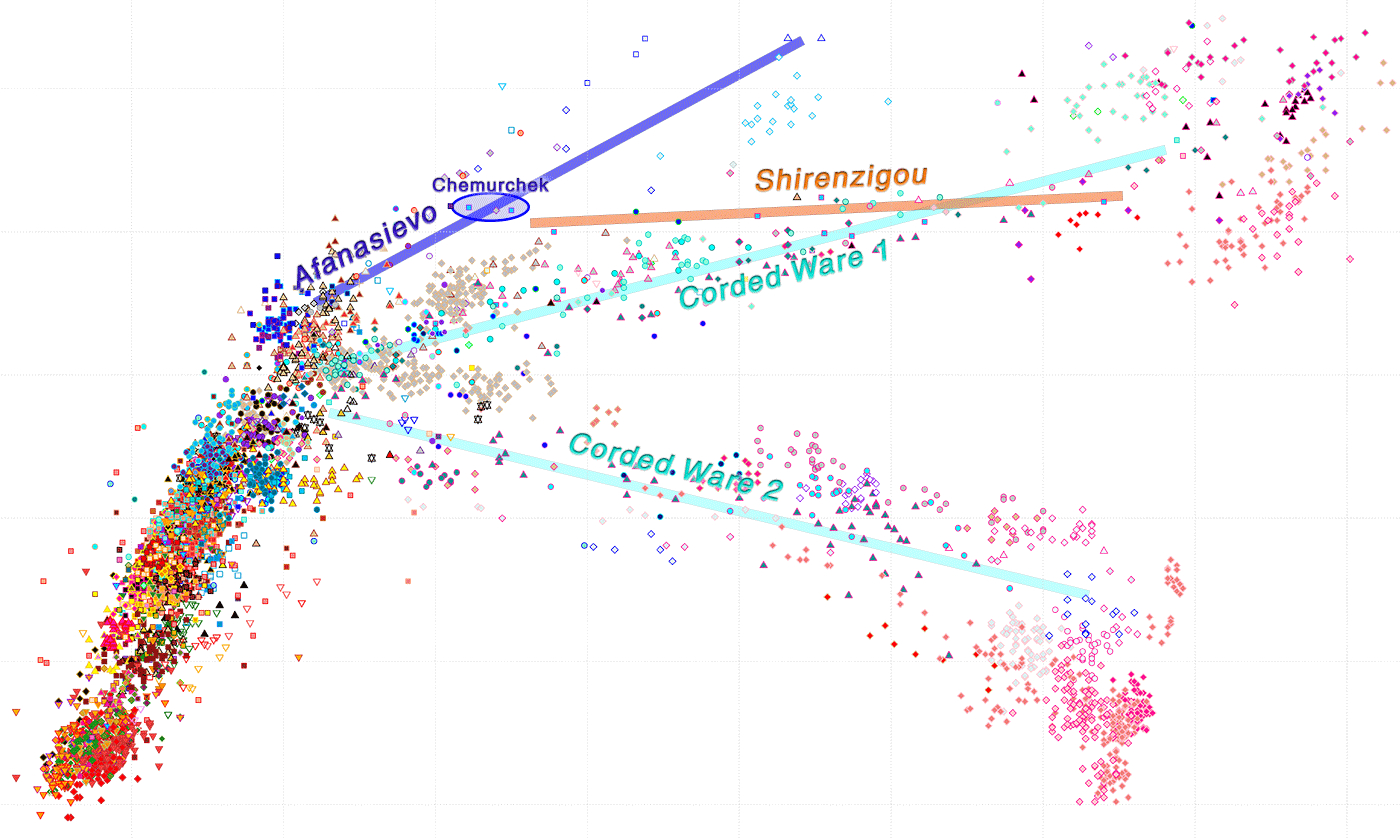
I think Wang et al. (2020) have exhausted all alternative ancestral and modern proxies for Shirenzigou, but here are nevertheless more direct models for some of the (apparently) more Steppe-shifted individuals:
Since Chemurchek is already a mixture of Afanasievo and Central_Steppe_EMBA ancestry, it is only natural that the three-way models offering good fits in Wang et al. (2020) must eventually give way to better fitted two-way models of more recent populations, such as Mongolia_East_N + Chemurchek vs. Sintashta.
A comparison of (coeval) Sintashta vs. Chemurchek as potential proxies of their “Steppe ancestry” gives roughly the same results as in Ning et al. (2019) and Wang et al. (2020), rejecting either Sintashta or Chemurchek, which confirms my previous suggestion that both Afanasievo- and Corded Ware-related sources likely contributed to this population, and that more specific direct ancestral sources of Afanasievo-related ancestry after their admixture with Corded Ware-related peoples are needed to get a clearer picture.
NOTE. Based on the simplistic clines drawn in the PCA of ancient and modern East Asians above, it is clearly a more reasonable solution to draw different ‘subclines’ from a Sintashta-Mongolia_East_N cline to the Chemurchek cluster, just as there should be multiple Corded Ware-related ‘subclines’ drawn, too.
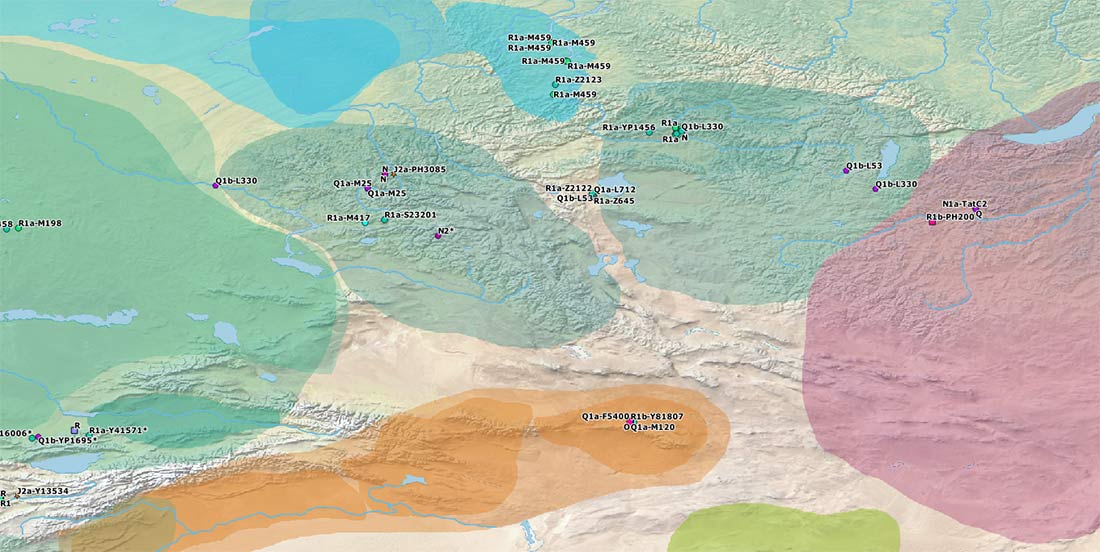
PCA, ADMIXTURE, FST and qpAdm analyses all point unequivocally to the sampled Shirenzigou population as partially continuing Chemurchek ancestry, and partially related to the absorbed (or superimposed?) Corded Ware-like population from Xinjiang, the Altai, and/or the Hexi Corridor.
So this community clearly represents either a Common Tocharian population, or a closely related Chemurchek-derived group that went extinct after they became immersed within the Iron Age movements from the East. But, what do we know about Y-DNA among Common Tocharians? Sampled Turkic peoples might hold a relevant clue:
NOTE. Even though we expected something similar based on the presence of M269 in Y-DNA among modern Uyghurs, the picture is more complicated than that, because sampled peoples in the paper are Old Uyghurs, ethnically different from their modern namesakes in Xinjiang, and they too migrated later to the Tarim Basin.
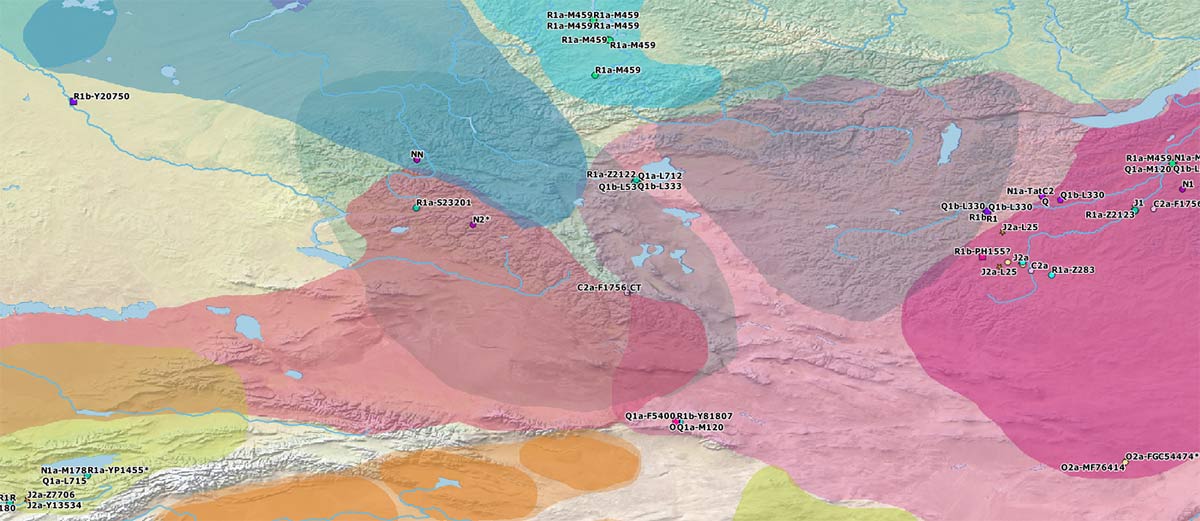
III. Old Uyghurs
III.1. Western Eurasian ancestry
Although our sample representation for the Early Medieval period is uneven, consisting of one unclassified individual dating to the Xianbei or Rouran period (TUK001), 8 individuals from Türkic mortuary contexts, and 13 individuals from Uyghur cemeteries, it is clear that these individuals have genetic profiles that differ from the preceding Xiongnu period, suggesting new sources of gene flow into Mongolia at this time that displace them along PC3. Individual TUK001 (250-383 cal. CE), whose burial was an intrusion into an earlier Xiongnu cemetery, has the highest western Eurasian affinity.

The high genetic heterogeneity of the Early Medieval period is vividly exemplified by twelve individuals from the Uyghur period cemetery of Olon Dov (OLN; Fig. 2), in the vicinity of the Uyghur capital of Ordu-Baliq. Six of these individuals came from a single tomb (grave 19), of whom only two are related (OLN002 and OLN003, second-degree); the absence of closer kinship ties raises questions about the function of such tombs and the social relationships of those buried within them. Most Uyghur period individuals exhibit a high, but variable, degree of west Eurasian ancestry – best modeled as a mixture of Alans (a historic nomadic pastoral group likely descended from the Sarmatians and contemporaries of the Huns (Bachrach, 1973)) and an Iranian-related (BMAC-related) ancestry – together with Ulaanzuukh_SlabGrave (ANA-related) ancestry. The admixture dates estimated for the ancient Türkic and Uyghur individuals in this study correspond to ca. 500 CE: 8±2 generations before the Türkic individuals and 12±2 generations before the Uyghur individuals (represented by ZAA001 and Olon Dov individuals).

Among six Old Uyghur samples from Olon Dov, Arkhangai (ca. AD 744-840 CE) there are four unrelated males of hg. R1b-M269, three of them of hg. R1b-Z2103:
Most of the burials excavated were discovered beneath large earthen enclosures that contained ritual structures for venerating the uppermost elites. These conspicuous ritual enclosures occur as single monuments or in small groups, and they are found in several locations throughout the foothills of the nearby the Uyghur capital. These monumental tombs with ramp entries and vaulted brick chambers were likely reserved for the ruling nobility of the Uyghur empire (Odbaatar 2016).
The closest R1b-M269 samples found to date close to that area are indeed Afanasievo, Chemurchek, and early Okunevo-related individuals, but beyond the EBA only Scythians or Sarmatians from the Pontic-Caspian steppes show this subclade, similar to previous groups that admixed with Pre-Proto-Indo-Iranian-speaking Poltavka herders, such as Sintashta-Potapovka or Srubnaya.
NOTE. A sample from Mezhovskaya (ca. 1500 BC), of hg. R1b-M269, might be the closest one from the west. That is, if it were R1b-L23, representing Abashevo-related lineages ultimately from Poltavka in the Middle Volga forest-steppes. But it could also be an infiltrated basal R1b-M269* lineage among early Uralic peoples, from hunter-gatherers of the Cis-Urals.

III.2. Uyghur origins
These are excerpts and images from An Historical Atlas of Central Asia, by Yuri Bregel Brill (2003):
From 640 to 657 the intertribal and interdynastic wars continued and were exacerbated by the general uprising of the Oghuz (Tiele) in the north, until the army of the Tang invaded Semirech’e, defeated the troops of the western tribes, and captured the last qaghan, who died two years later in captivity.
Thus, the First Türk Qaghanate actually ceased to exist, both in the east and in the west, in 630, though the agony of the Western Qaghanate lasted until 657. The First Türk Qaghanate played an extremely important role in the political and ethnic history of Central Asia. Its conquests were accompanied by the migrations of Turkic tribes, which spread over vast territories of Eurasia. Due to the Qaghanate’s westward expansion, Turkic tribes completely replaced the Iranian nomads in the northern steppes.
There was, however, a simultaneous peaceful expansion of an Iranian ethnic element in the opposite direction that had already begun under the Hephthalites. By that time Soghdian merchants became instrumental in the trade in silk and other luxury items on the Great Silk Route. Soghdian trade colonies along the Great Silk Route flourished; some of them became significant cities whose population, engaged not only in commerce but also in agriculture, became ethnically mixed. Dozens of Soghdian colonies spread as far as Mongolia and north-western China (the region of Ordos), and Soghdians became advisors and instructors of the Türk rulers. The first Turkic alphabet used in the so-called runic inscriptions of the 7th-8th centuries was probably developed in the middle of the 7th century on the basis of the Soghdian alphabet (however, there are also other theories of its origin), and Soghdians served as interpreters and ambassadors in diplomatic missions that travelled from the Qaghanate to Iran and Byzantium. With the penetration of the Turks into the oases of Eastern and Western Turkestan, a gradual mutual assimilation of the nomadic Turkic and the sedentary Iranian population began which was to continue into the 20th Century.
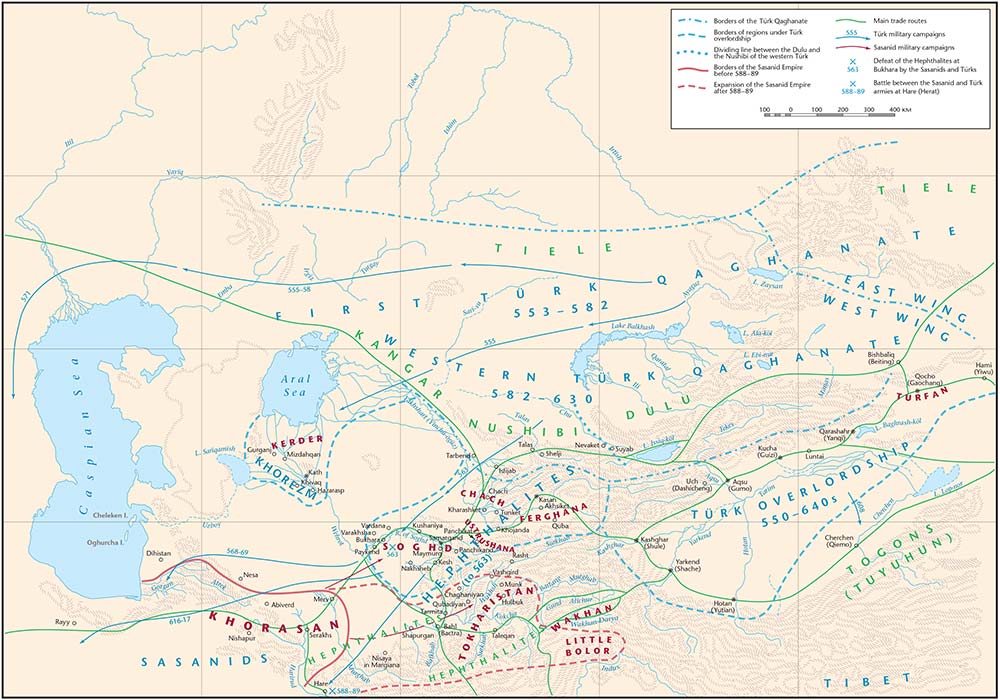
Uyghur Qaghanate
(…) in 737 Suluk was defeated by the Arabs, and upon his return to Semirech’e he was killed by one of the Türgesh tribal chieftains; within just three years the Türgesh Qaghanate had completely disintegrated. The Second Qaghanate of the Eastern Türks lasted not much longer. In 742 the last qaghan of the Ashina dynasty was killed; a brief feud followed among three tribal groups who had been the Türks’ vassals, the Basmïl, Qarluq, and Uyghur. The Uyghurs, who had belonged to the Tiele, or Toquz-Oghuz, group of Turkic tribes, came out victorious, and in 744 they founded their own, Uyghur, qaghanate (with the same traditional center in Mongolia). In 745 the defeated Qarluqs migrated to the southwest, to the land of the former Türgesh Qaghanate.
In Eastern Turkestan, in the meantime, Chinese fortunes suffered a sudden reversal. In 756 a major uprising in China inflicted a heavy blow to the Tang. Most of the Chinese troops in the “Four Garrisons” region were withdrawn, with the exception of Kucha and Beiting, but even these lost their connection with the Chinese heartland. The Uyghurs, who helped the Tang to fight the rebellion and to drive the rebels away from the Tang capital, established their control over the northern part of the Tarim basin. While the Uyghur qaghan, named Bögü (759-779), stayed in the Tang capital in 762, he was converted to Manichaeism by the Soghdians who lived there, and Manichaeism became the official religion of the Uyghurs. As a result, Soghdian political and economic influence in the Uyghur Qaghanate became stronger than ever before, and Soghdian merchants profited greatly due to their role as intermediaries in the trade in silk and horses between the qaghanate and China. Bögü Qaghan was overthrown and killed, and the new qaghan, Alp Qutlugh Bilge (779-789), persecuted the Manichaeans. His successors restored Manichaeism to its previous status. In Eastern Turkestan this period coincided with a major offensive of Tibet, where Buddhism became the official religion in 787. In the 780s and 790s the Tibetans captured Hami, Bishbalïq, Qocho, and Hotan. The Uyghurs were still able to counterattack, and in 803 they recaptured Qocho. The struggle for the cities of the Tarim basin between the Tibetans, the Chinese, and the Uyghurs continued until the 820s. In 822-823 Tibet made peace with China and with the Uyghurs. But the situation of the Uyghur Qaghanate rapidly deteriorated. The Uyghurs were losing ground in their wars with the Qïrghïz (a Turkic people in the Yenisey basin, north of Mongolia), which lasted for two decades. In 840 the Qïrghïz, assisted by a renegade Uyghur general, captured the capital of the Uyghur Qaghanate in Mongolia and killed the last qaghan; the Qïrghïz ruler proclaimed himself qaghan, thus founding a new, Qïrghïz, qaghanate, which had no connection with the political tradition of the Türk and Uyghur qaghanates. The Uyghurs fled from Mongolia and Jungharia in various directions.
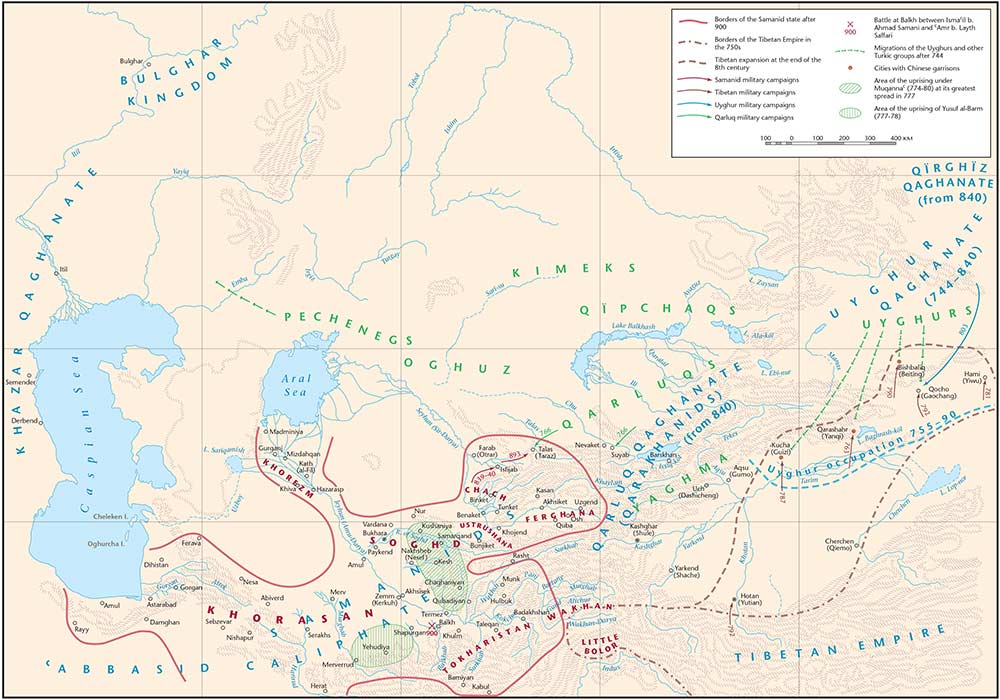
III.3. Proto-Indo-European lineages in the Middle Ages
Apparently, then, the prototypical Late Proto-Indo-European R1b-L23 lineages survived in Asia well into the historical period, with R1b-Z2103 found among Old Uyghur elites from Mongolia. Their ultimate origin is unclear, but Old Uyghurs are supposed to stem from somewhere between the Upper Yenisei region and Xinjiang, with the genetic profile of sampled mid-8th-to-9th-century individuals likely reflecting the intense interactions with Turan, the Tarim Basin, and the Altai during the previous century.
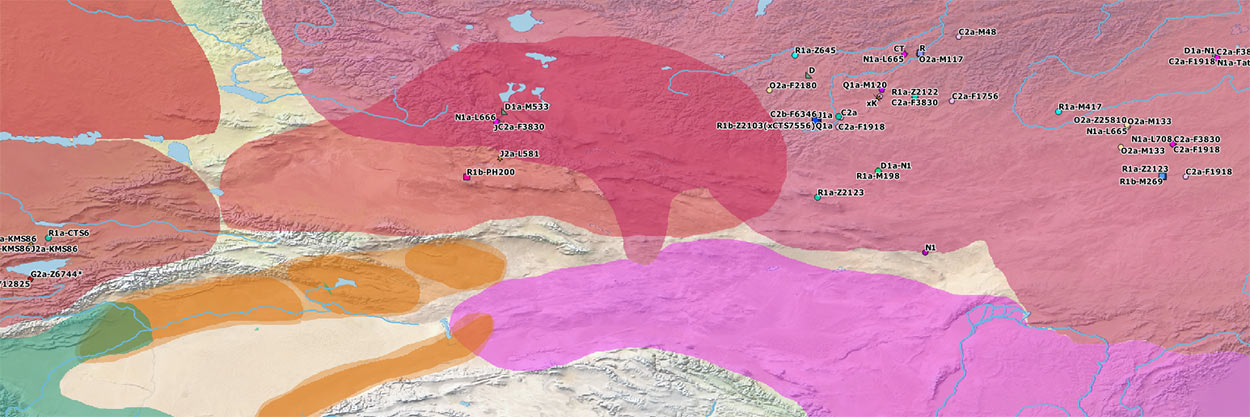
Based on the lack of hg. R1b-Z2103 anywhere close to that area among sampled populations from related groups and in preceding periods, there are two simple explanations for the emergence of these lineages in Mongolia:
A. They form part of expanding Iranians, very much like the samples continuously found among steppe peoples since the expansion of the Srubnaya-Andronovo horizon. That would be supported by the “Alan” ancestry assessed by Jeong et al. (2020), and it would show once again that the strong Sintashta-Potapovka-Filatovka bottlenecks under R1a-Z93 lineages (continued regionally among later Iranian and Indo-Aryan groups) remained an incomplete process in the steppes and beyond, strengthening the continuity of Pre-Proto-Indo-Iranian lineages after their admixture with Uralic peoples.
B. They represent lineages from acculturated Proto-Tocharians or Common Tocharians from the Altai – Tian Shan – Tarim Basin region, in line with the known infiltration and expansion of varied haplogroups among Iron Age societies, in particular among nomads who constantly formed shifting regional alliances. This is compatible with the expected Yeniseic over Samoyedic substrate being replaced by Proto-Tocharians in the area, and thus with these lineages being found in the Tarim Basin (and in regional pockets to the north of it) during the Middle to Late Bronze Age and beyond.
More than on ancestry, as Jeong et al. (2020) proved once more with their weirdly selected ancestral models, this question will likely be resolved based on a sufficiently deep haplogroup inferences that connect lineages from available samples of potentially related cultures, from Chemurchek up to historical Tocharians through the Tian Shan.
Related
On Tocharians and Proto-Indo-Europeans
- Samoyedic shows Yeniseic substrate; both influenced Tocharian
- Proto-Tocharians: From Afanasievo to the Tarim Basin through the Tian Shan
- Yamnaya replaced Europeans, but admixed heavily as they spread to Asia
- Iron Age Tocharians of Yamnaya ancestry from Afanasevo show hg. R1b-M269 and Q1a1
- Bronze Age cultures in the Tarim Basin and the elusive Proto-Tocharians
- A study of genetic diversity of three isolated populations in Xinjiang using Y-SNP
On Corded Ware and Uralic – Indo-Iranian
- Intense but irregular NWIE and Indo-Iranian contacts show Uralic disintegrated in the West
- Corded Ware ancestry in North Eurasia and the Uralic expansion
- Uralic speakers formed clines of Corded Ware ancestry with WHG:ANE populations
- Early Uralic – Indo-European contacts within Europe
- Aquitanians and Iberians of haplogroup R1b are exactly like Indo-Iranians and Balto-Slavs of haplogroup R1a
- The complex origin of Samoyedic-speaking populations
- The traditional multilingualism of Siberian populations
- Haplogroup R1a and CWC ancestry predominate in Fennic, Ugric, and Samoyedic groups
- Corded Ware—Uralic (III): “Siberian ancestry” and Ugric-Samoyedic expansions